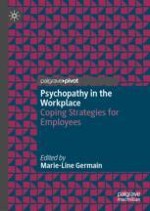2024 | OriginalPaper | Chapter
8. Using the Workplace Power Control Wheel to Name Abusive, Bullying, Controlling, and Coercive Behavior by Corporate Psychopaths at Work
Author : Hannah Scott
Published in: Psychopathy in the Workplace
Publisher: Springer International Publishing
Activate our intelligent search to find suitable subject content or patents.
Select sections of text to find matching patents with Artificial Intelligence. powered by
Select sections of text to find additional relevant content using AI-assisted search. powered by
